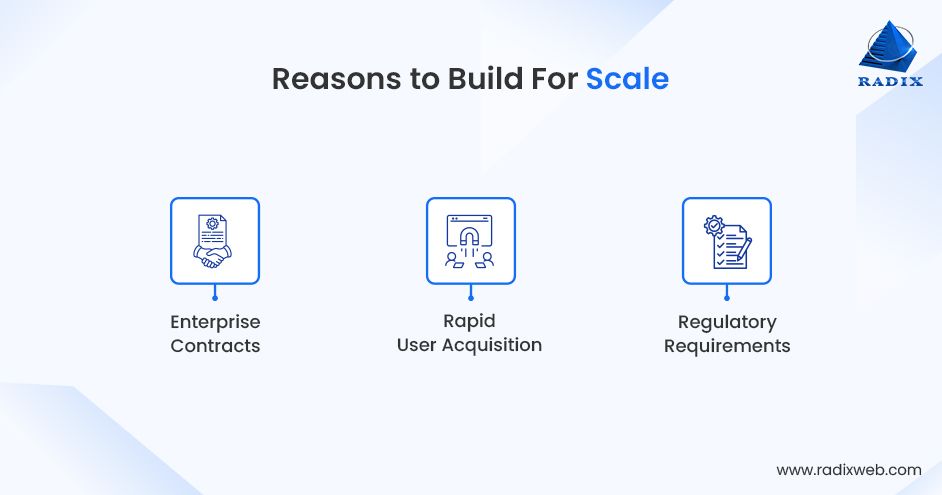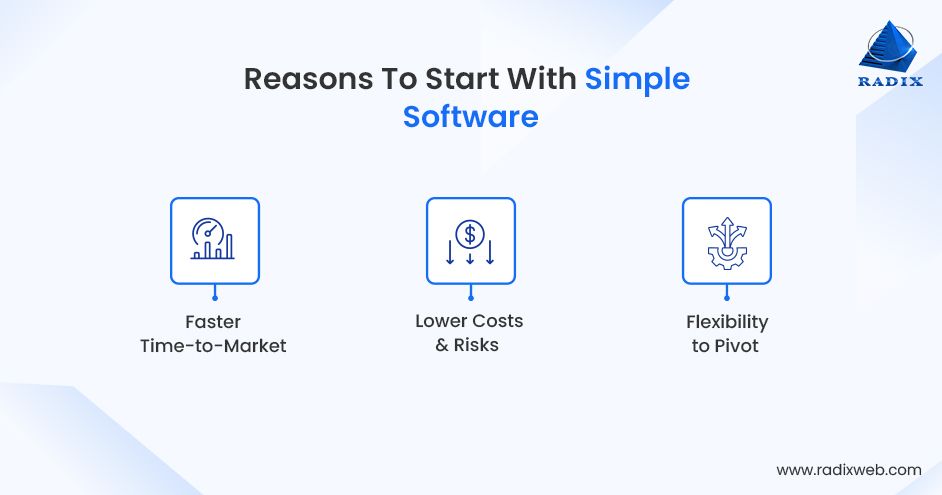Read More

Skip Setup Headaches and Start Your Project Fast - Download Free Boilerplates
ON THIS PAGE
- Monolithic Architecture vs Microservices
- Factors to Consider For Choosing Monolithic vs. Microservices Architecture
- Simplicity vs Scalability Across The Entire Tech Stack
- When To Build For Scale Early?
- When To Build For Simplicity?
- Software Architecture Decision Framework
- Building For Simplicity Today and Scalability Tomorrow
ON THIS PAGE
- Monolithic Architecture vs Microservices
- Factors to Consider For Choosing Monolithic vs. Microservices Architecture
- Simplicity vs Scalability Across The Entire Tech Stack
- When To Build For Scale Early?
- When To Build For Simplicity?
- Software Architecture Decision Framework
- Building For Simplicity Today and Scalability Tomorrow
Summary: For over 25 years, Radixweb has guided businesses in making software decisions. Our goal is to help you carefully balance simplicity and scalability in software design. The enduring debate between monolithic and microservices architectures remains central. Yet many projects suffer from overengineering. The outcome? Inflated costs, delivery delays, and maintenance challenges. Recently, a Reddit thread discussing overengineering in software development went viral. So we analyzed over 300+ comments on the thread, offering with diverse opinions and real-world examples. This blog distills those practical insights combined with Radixweb’s industry experience.
The pressure to “future-proof” software architecture is a familiar refrain in technology circles. Building systems that can handle rapid user growth or new features later on is appealing. Yet it comes with its own set of risks.
It often manifests as complex software solutions with features and infrastructure that aren't needed now.
Now, this might seem like prudent preparation at once. But in reality, it frequently leads to:
- Longer project timelines as the added complexity increases development and testing effort.
- Inflated costs as more components mean higher development, infrastructure, and operational expenses.
- Long-term maintenance struggles as complex systems are harder to debug, update, and scale further.
- Slower iteration and reduced innovation as teams spend more time managing technical debt and operational overhead.
A Reddit thread with 300+ comments revealed how pervasive this challenge remains. Several anecdotes in the comments described startups and (even some established companies!) struggling under the weight of unnecessary technical complexity. Ultimately, their ability to deliver features and respond to market needs remained stalled. At Radixweb, we’ve seen these patterns too. Not once, but repeatedly. The challenge here is to balance ambition with pragmatism and building software that meets today’s requirements and is ready to grow tomorrow.
How? Dive in to find out.
Monolith Architecture vs Microservices: Choosing the Right Software Architecture for Your Business
The core question that the Reddit thread aims to answer is:
Before we dive into what Redditors had to say about that, let's first understand...
What Is Monolithic Architecture?
Monoliths are single, unified codebases where all components and features are tightly integrated. This type of architectural approach allows rapid development cycles, easier debugging, and simpler deployment processes. It is especially useful for smaller teams and early-stage products.
What Is Microservices Architecture?
Microservices architecture is where functionality is split into small, independent services. These services communicate over networks and enable scalability, resilience, and parallel development by multiple teams. However, it introduces operational complexity like service orchestration, network latency, and distributed debugging. This should be kept in mind when deciding when to use microservices.
Important: Microservices architecture is often confused with APIs but they aren't the same. Check out the differences between microservices and APIs here.
What Are Main Differences Between Microservices And Monolithic Architecture?
The table below explains what are the main differences between microservices and monolith architecture:
| Aspect | Monolithic | Microservices |
|---|---|---|
| Structure | Single codebase | Multiple independent services |
| Deployment | Deploy whole app | Deploy services separately |
| Scalability | Scale entire app | Scale individual services |
| Tech Stack | One stack for all | Different stack per service |
| Fault Impact | One failure can crash all | Failure isolated to service |
| Speed | Quick to start | Slower start, faster later |
| Communication | In-process calls | Network/API calls |
| Maintenance | Harder as app grows | Easier to evolve individually |
| Best For | Small/medium apps | Large, complex systems |
Overall, monoliths are simpler and faster to build for small projects, while microservices offer greater flexibility and scalability for complex, growing systems.
Monoliths vs. Microservices Architecture: Which One To Choose?
Neither architecture - monoliths or microservices - is a silver bullet. Both monoliths and microservices have successful and failed implementations. However, from the Reddit thread (and Radixweb’s decades of delivery experience!) clear patterns emerge:
- Many successful SaaS products start as monoliths. This accelerates time to market and focus on core features.
- When user base and features grow large (often beyond several hundred thousand users!) teams begin modularizing and migrating to microservices. This reduces bottlenecks and enable independent development streams.
- Premature adoption of microservices, (especially in startups with small teams and limited demand!) causes operational overhead, deployment challenges, and a steep learning curve that stalls delivery.
Remember: If you already have software with monolithic architecture that has outgrown your needs, consider enterprise application modernization for the monolith or migrating to microservices. Careful planning and focused execution can help you make the move without disruptions.
Important Considerations When Considering Monolithic vs. Microservices Architecture
Before you make a choice between the two, here are some factors that you should consider:
Team Expertise Matters
Do you have engineers skilled in distributed systems and CI/CD pipelines? Without this, microservices may introduce more risk than benefit.
Operational Readiness
Microservices complexity require investment in container orchestration, service mesh, logging, and monitoring. These tools and processes add a lot of complexity and cost to your project.
Business Needs Over Trends
Choosing microservices “because everyone else is” is a mistake. Align architectural choices with business goals, timelines, and resources.
Specific Feature or Security Requirements
Some specific feature requirements also require splitting a monolithic architecture into microservices. It also supports security. As one Redditor explains, "I personally prefer to split services based on what they access to minimize impact of potential vulnerabilities, breaches etc.... I think permission minimization is very hard to do in monolithic contexts..."
“Monolithic architecture vs. microservices should be treated as a “when” choice. As in when you move to microservices, not “if”. But start simple and iterate fast. Then you can scale architecture as demand and capabilities evolve."
Bhadresh Panchal, Project Lead specializing in clean code architecture, Radixweb
Beyond Architecture: Balancing Simplicity vs Scalability Across Your Entire Tech Stack
The debate between monoliths and microservices is just one dimension. The broader tension lies between simplicity and scalability. And this debate that permeates all layers of your software tech stack.
So, should you keep your software architecture simple? Or should you factor in everything you need to scale right on day 1?
Well, to begin with, consider these layers where complexity creeps in:
Hosting & Deployment Pipelines
Starting with straightforward VM or PaaS solutions can simplify operations. Introducing Kubernetes or complex CI/CD early adds overhead before it’s needed.
Data Storage
Choosing relational databases initially might suffice. Premature sharding, polyglot persistence, or NoSQL adoption can increase complexity without clear benefits.
Third-Party Services
Integrating multiple APIs or complex authentication mechanisms too early can cause unnecessary failures.
Observability & Automation
Over investing in monitoring or even auto-scaling tooling before having stable usage patterns can overwhelm engineering and maintenance teams.
Radixweb encourages starting lean across all these layers. Add operational and architectural complexity when usage and business needs clearly demand it. Having said that, sometimes you do need to build for scale from the get go.
When Does Building for Scale Early Make Sense?
One of the Redditors who weighed in on the debate, gave a perfect example of when early scalability in software design (often powered by complex architecture!) makes sense. They mentioned, "I make complicated architectures because modern software requires it. Do you want to handle concurrency issues or just ignore it? Do you want correlation ids in your logs to make it easy to follow complicated flows when you have 1M requests per second? Do you want a UI that is intuitive, nice to look at, and supports every mobile device out there? All of those things are hard to do with 'simple' architectures."
This proves that scaling early is not inherently wrong. Sometimes it is what is needed. Certain business triggers that justify this upfront investment include:

Enterprise Contracts With Strict SLAs
Large customers may demand uptime guarantees and reliability. This often necessitates fault-tolerant architectures from the start.
Plans For Rapid User Acquisition
Well-capitalized startups with clear growth paths can justify building scalable infrastructure upfront. This helps them avoid painful (and costly!) rewrites later.
Regulatory or Compliance Requirements
Industries like healthcare and finance require secure, audited, and resilient infrastructures. This often drives the push toward complex architecture early.
In such situations, the benefits of early scalability extend beyond the basic needs. It also helps:
- Avoid costly “fire drills” when rapid growth overwhelms systems.
- Minimize downtime and customer impact during scaling events or migrations.
- Win large enterprise deals by demonstrating future-ready infrastructure capabilities.
However, these benefits only materialize when backed by reliable business signals and experienced teams to manage complexity.
The Case for Starting Simple: Building Just Enough
"People need to start with the mentality of what's the simplest way I could achieve this" says one of the Redditors and we, at Radixweb, absolutely agree.
We've always focused on alignment of business needs with tech instead of running behind the 'cool' stuff. We know power of digitally nimble solutions that can still scale and grow with you.
That’s why, in many cases simplicity trumps fancy and complex and delivers strategic advantages like:

Faster Time-to-Market
You get a working MVP to users quickly, capturing feedback and validating hypotheses. Early launches help you spot market fit issues before investing heavily. Then, you can iterate faster based on real-world usage.
Lower Costs & Risks
You can avoid expensive infrastructure that may never be needed. Starting small also reduces technical debt, minimizes wasted effort, and allows budget to be focused on proven features.
Flexibility To Pivot
Simpler systems are easier to change or abandon if business needs shift. That kind of flexibility can prove to be a major business advantage when the time comes.
A Reddit participant shared a cautionary tale of a startup investing hundreds of thousands in an enterprise-grade backend before proving product-market fit, resulting in sunk costs and missed opportunities.
To directly quote them, "We had a full Microservice and a Kafka cluster for about 25k users with very less interaction on the platform. Users logged in once a while. Building features took forever, because everything has to be collocated. We had to build for 100 of thousands of concurrent users, which will never come."
Another one adds, "No way am I engineering a product for 10 people on the assumption that “one day” it might need to be used by tens of thousands..."
At Radixweb, we too champion lean MVPs with essential functionality. This helps us minimize wasted spend and maximize agility.
How To Decide: Software Architecture Decision Framework For Balancing Scalability & Simplicity
Finding yourself in the middle of a software simplicity vs. scalability debate? Well, instead of jumping to a conclusion based on the latest software trends or what others are doing, here's a simple software architecture decision framework you can use to make an informed choice:
1. Growth Certainty
Assess your confidence in user growth and market demand. Is it based on validated contracts, pilots, or steady user adoption? Avoid basing decisions on optimistic forecasts or “what-if” scenarios.
2. Funding Runway
Scalable architectures are not just upfront costs. They require ongoing investment in specialized talent, monitoring, and maintenance. See what your budget allows now and how much money you'd be able to spend to continue using the software.
3. Downtime Tolerance
Understand your users’ tolerance for downtime or performance degradation. For mission-critical apps, investing early in resilient architectures is vital.
4. Team Capacity
Evaluate your team’s experience with complex systems. If they lack skills in distributed architectures, microservices, or container orchestration, it may be better to start simple and invest in training.
5. Time to Market
If speed is essential, prioritize simple architectures that enable rapid iterations. You can optimize for stability and scale later once product-market fit is confirmed.
Important: At Radixweb, we use pilots as a standard practice to de-risk architecture decisions. It helps us (and our clients understand user needs and expectations better. And that's what powers informed incremental scaling.
The Final Take: Build What Fits Today & Is Ready For TomorrowNo single software architecture suits all. Each project is unique. Each software has its own blend of market conditions, resources, team skills, and strategic priorities.By rigorously assessing your growth certainty, funding, downtime needs, team capacity, and market timing (and validating assumptions through pilots!) you can avoid the costly extremes of premature complexity or last-minute firefighting.Ready to Build Software That Fits Your Business? Whether you’re a startup launching an MVP or an enterprise planning for growth, Radixweb’s 25+ years of experience in following software architecture best practices can guide you to make the right decisions. Contact us today to discuss how we can help you balance simplicity and scalability.
FAQs
Is overengineering always bad?
When is the right time to move from monolith to microservices?
How can I tell if my vendor build overengineered software?
Ready to brush up on something new? We've got more to read right this way.








